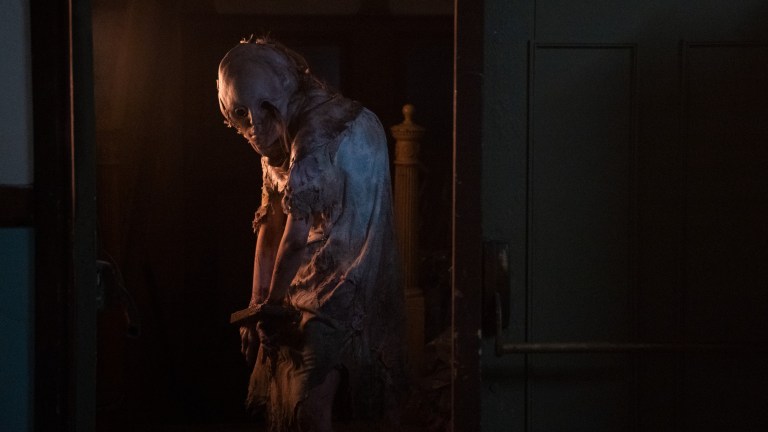How Resident Evil: Welcome to Raccoon City Wants to Get This Franchise Right
Resident Evil: Welcome to Raccoon City director Johannes Roberts talks about the film's influences, style, and what it means to get a Resident Evil movie "right."

Before Resident Evil became a best-selling video game franchise, it was a passion project with a simple purpose: to scare the hell out of a generation of unsuspecting gamers. While 2002’s Resident Evil movie shared the 1996 game’s name, it emphasized sci-fi storytelling and action over scares. That movie—and the five sequels that followed—became box office hits, but ultimately divided video game fans who wondered if those movies really got the fabled franchise “right.”
For Resident Evil: Welcome to Raccoon City director Johannes Roberts, the chance to reboot this franchise is less about correcting past mistakes than making the most out of the opportunity to explore what makes the games different.
“I had a great time with those movies,” Roberts says of the Resident Evil live-action films. “But as I’ve got older, I’m much more of a gamer than I’ve ever been…I approached this film from a gaming perspective.”
From that perspective, Roberts was able to focus on the one thing that the Resident Evil films haven’t quite gotten right to this point: horror.
“The pitch for the movie was to go back to the series’ horror roots,” Roberts says. “The key was to make a horror movie…to make something scary…to make a survival movie…I really wanted to recreate the fear of playing that first game.”
Welcome to Raccoon City may aspire to recreate the fear of the first game, but the film actually utilizes characters and locations from the first two Resident Evil games. It follows franchise favorite characters Chris and Claire Redfield (Robbie Amell and Kaya Scodalario), Leon Kennedy (Avan Jogia), and Jill Valentine (Hannah John-Kamen) as they try to survive the night across two iconic gaming locations: Resident Evil’s Spencer Mansion and Resident Evil 2’s Raccoon City Police Station.
Of course, locations and characters are only part of the Resident Evil experience, especially if we’re talking about the first two games in the series. After all, those are the games that introduced the fixed cameras, limited resources, confusing controls, and other restrictive elements that strangely helped elevate the terror of the franchise by making you question how confident you were in your gaming abilities. You often didn’t know where enemies were or if you were ready to fight them.
While it’s obviously impossible to recreate all of those mechanical and presentation elements that helped the original Resident Evil games stand out, Roberts and his crew did find some ways to pay homage to some of the core components of those horror classics.
“We definitely play around with restrictive camera angles,” Roberts notes. “People walk off-screen and then they’ll back into view rather than having you follow them…even some of the actual camera angles, like the sort of high camera angles that were very iconic to the game…I would never use an angle like that normally because it sort of feels like a CCTV angle, but we use it a few times in the movie because it was fun and it very much reminds me of the game.”
While such homages will almost certainly grab the attention of hardcore fans, Roberts makes it clear that this movie is not just for those who already love Resident Evil.
“I very much leaned into recreating some of the things that I was excited to see,” Roberts says. “But I’m always wary about trying to specifically cater to fans because I can’t speak for what people like.”
It’s a fine line to walk. Whereas the previous Resident Evil movies arguably strayed too far from their inspirations, it’s easy enough to imagine how a movie could fail by trying the opposite approach. After all, if you’re just trying to recreate the games exactly as they were on the big screen, then you have to start to wonder what the point is.
Instead, Roberts and the Raccoon City crew seem committed to honoring the spirit and style of those classic Resident Evil games without coming across as a fan film.
“With both the narrative and characters, I didn’t just want to do a cosplay thing,” Roberts says. “I didn’t want the characters to have the exact haircut or exact dialog [from the games]. I wanted to feel emotionally attached to them and feel like they’re real people in a real town.”
The film’s emphasis on Raccoon City is the first deviation from franchise norms that will catch many fans’ attention. While the town is featured in early Resident Evil games, those titles rarely left you feeling like Raccoon City was a real community with a personality and story of its own. The change can partially be attributed to the influence of one of horror’s great small-town storytellers.
“[The movie] lives in a kind of Stephen King small-town world,” Roberts explains. “It’s like Derry. The actual place is rotten and dying.”
That dying town will not only help sell the terror of the film’s scenario but also conveys and contrasts with the movie’s ‘90s setting in some clever ways.
“Because the town is kind of this forgotten, timeless place, you could go back to it 50 years ago and it would be almost identical,” Roberts notes. “The trends and fads pass it by…I sometimes feel like when you watch a period movie set in a certain year and everything is specifically from that year…that’s just not how life is. You have stuff from all periods.”
So what happened to Raccoon City that could possibly justify using words like “rotten” and “dying” to describe the community? According to Roberts, the town’s woes can be attributed to its association with one of the most notorious names in the Resident Evil franchise: Umbrella.
“I look at Raccoon as a kind of Deer Hunter-esque place,” Roberts reveals. “Umbrella is moving out and has left a kind of dying town…not an evil place, but a dying, sick place.”
For those who don’t know, the Umbrella Corporation is pretty much the root of all evil in the Resident Evil universe. While many of Resident Evil’s monsters may appear to be supernatural or extraterrestrial, most are the result of Umbrella’s years worth of unchecked greed and dangerous experimentation.
As such, it’s certainly not a coincidence that Umbrella’s departure coincides with the sudden appearance of an army of zombies in Welcome to Raccoon City. While Umbrella and zombies are the two defining antagonists of the original Resident Evil games, the truth is that in a post-Walking Dead world the undead aren’t as much of a novelty as they once were. They’re instead one of those iconic elements of the games Roberts embraced but didn’t take for granted.
“When we did our first major scene with the zombies, I suddenly realized their history and baggage,” Roberts recalls. “I thought, ‘Wow, I have got to make this scary.’ I was very aware that if you get them wrong, they’re not scary.”
Rather than solely rely on Resident Evil’s Romero-esque zombies to still be effective all these years later, Roberts turned to an unlikely source for inspiration.
“I was very influenced by Chernobyl, the TV show,” he reveals. “I found it incredibly disturbing seeing the effects of the radiation and seeing how people get sick…but it was human. I really wanted to feel that within this scary, fun horror movie.”
Of course, Resident Evil fans know that zombies are sometimes the least of your worries. The games feature an array of horrors that can end your run before you’ve even had a chance to scream. While Welcome to Raccoon City will feature some of the games’ most notable threats, Roberts was careful to select creatures that fit into the film’s pure horror tone.
“We don’t play with the giant spider side of the games and the slightly ‘b-movie’ stuff,” Roberts reveals. “I wanted to lean into some of the more disturbing and creepy aspects of the game, and we’ve really gone to great lengths to recreate some of the really cool, terrifying creatures within the game world… I won’t give away anything, but yes, there are really fantastic creatures and terrifying set pieces.”
Monsters like that may contribute to the scary portion of the film, but what about the “fun” side of the movie Roberts mentioned? Well, some of that fun will come from the film’s action sequences, but Roberts turned to another somewhat unlikely source to ensure the action doesn’t dilute the horror.
“My viewpoint is that Resident Evil 2 [the game] is very similar to Assault on Precinct 13,” he notes. “I sort of used Assault on Precinct 13 as a cornerstone for the with the whole police station under siege perspective…it’s an action movie, but it’s also a siege movie. The foes aren’t supernatural, but they might as well be.”
For the film’s Spencer Mansion sequences, Roberts taps into the classic horror spirit that has made him one of the genre’s rising stars over the last 10 years.
“When Alpha Team goes up to the mansion, it’s more like a proper haunted house with dark, creepy, and long corridors,” he says. “You hear that [zombie] noise and think, ‘Fuck, it’s somewhere, it’s around one of these corners.’ We play with that a lot.”
Such a contrast of styles reminds us that for all the talk about getting Resident Evil “right” on film, this is a video game franchise that has successfully embraced many different styles over the years. Getting Resident Evil right is really a matter of deciding which Resident Evil you’re talking about.
For Roberts, though, there is one thing that his Resident Evil story needs to emphasize in order to do this franchise justice.
“It’s about atmosphere, 100%,” he notes. “I would just say to the cast and crew, ‘Fall in love with this world that these characters are in.’ It’s dark, it’s raining, it’s bleak, and it’s scary, but it’s also fun. You leave the cinema with a smile on your face.”
Resident Evil: Welcome to Raccoon City is scheduled to be released in theaters across the United States on November 24.
